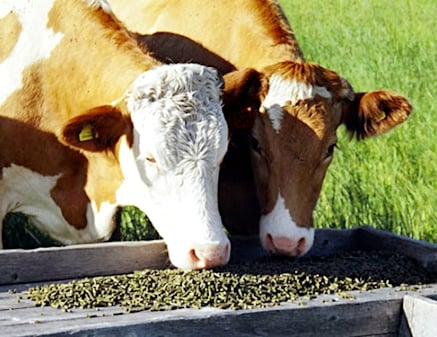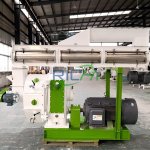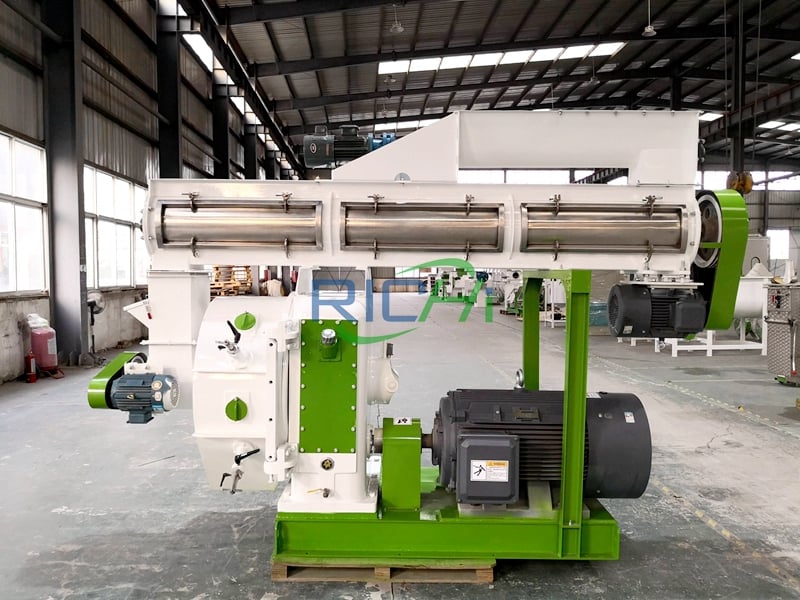What Are the Uses of Processing Alfalfa into Pellets?
Alfalfa, a highly nutritious forage crop, is commonly used in livestock feed due to its rich content of proteins, vitamins, and minerals. Processing alfalfa into pellets is a method that maximizes the crop’s potential by enhancing its storage, handling, and nutritional benefits. Here are the key uses of processing alfalfa into pellets:
1. Enhanced Nutritional Delivery
Alfalfa is known for its high nutritional value, which is crucial for the growth and health of livestock, particularly ruminants like cattle, sheep, and goats. Pelleting alfalfa ensures that these nutrients are evenly distributed and preserved, providing a balanced diet to the animals. The pelleting process also reduces nutrient loss that can occur due to oxidation or spoilage in loose hay.


2. Improved Digestibility
Pellets are easier for animals to digest compared to loose hay or chopped alfalfa. The pelleting process breaks down the fibrous structure of the plant, making it more digestible. This improvement in digestibility can lead to better feed conversion rates, meaning that animals gain more weight or produce more milk per unit of feed consumed.
3. Convenient Storage and Handling
Alfalfa pellets are compact and take up less space than loose alfalfa, making them easier to store and transport. This is particularly beneficial for large-scale farming operations where storage efficiency is a priority. Pellets are also less prone to spoilage and pest infestations, ensuring that the feed remains in good condition for longer periods.
4. Precise Feeding
Pellets allow for more accurate measurement and distribution of feed, ensuring that each animal receives the correct amount of nutrients. This is particularly important in controlled feeding environments such as feedlots or dairies where precise nutrition management is essential for optimizing animal health and production.
5. Versatile Applications
Alfalfa pellets are versatile and can be used in various feeding programs for different types of livestock, including cattle, horses, rabbits, and poultry. Additionally, alfalfa pellets are used as organic fertilizers in agriculture, providing a natural source of nitrogen and other essential nutrients to the soil.
How to Process Alfalfa into Pellets
Processing alfalfa into pellets involves several key steps, each critical to producing high-quality pellets that meet the nutritional needs of livestock. The process typically includes the following stages:
1. Harvesting and Drying
Alfalfa is harvested when it reaches the optimal stage of growth, usually when it is about 20-25 inches tall. After harvesting, the alfalfa is dried to reduce its moisture content to around 15%. Proper drying is essential to prevent mold growth during storage and to ensure efficient pelletization.
2. Grinding
Once dried, the alfalfa is ground into a fine powder using a hammer mill or similar equipment. Grinding reduces the size of the alfalfa particles, making them more uniform and easier to compress into pellets. The finer the grind, the denser and more durable the pellets will be.
3. Conditioning
The ground alfalfa is then conditioned by adding steam or water to it. This step softens the fibers and increases the temperature of the material, which helps to bind the particles together during the pelletizing process. Conditioning also improves the durability and quality of the pellets.
4. Pelletizing
The conditioned alfalfa is fed into a pellet machine, where it is compressed and forced through a ring die to form pellets. The ring die is a key component that determines the size and shape of the pellets. The pressure and heat generated during this process cause the alfalfa to bind together, forming dense, uniform pellets.
5. Cooling and Packaging
After pelletizing, the hot alfalfa pellets are cooled to room temperature using a pellet cooler. Cooling hardens the pellets and reduces their moisture content, making them more stable for storage and handling. Once cooled, the pellets are screened to remove any fines (small, broken pellets) and then packaged for storage or transportation.
The Characteristics of RICHI Alfalfa Pellet Mill
RICHI Machinery offers a range of alfalfa pellet mills that are designed to meet the specific needs of feed producers. These pellet mills are known for their efficiency, durability, and precision. Some of the key characteristics of RICHI alfalfa pellet mills include:
1. High Efficiency
RICHI alfalfa pellet mills are engineered to deliver high efficiency in the pelletizing process. They are designed to produce large volumes of pellets with minimal energy consumption, making them cost-effective for large-scale operations. The machines operate continuously, ensuring consistent pellet production without downtime.
2. Durability and Longevity
RICHI pellet mills are constructed with high-quality materials that ensure durability and long-term performance. The machines are built to withstand the rigors of processing fibrous materials like alfalfa, reducing the frequency of maintenance and repairs. This durability translates to lower operational costs over the lifespan of the machine.
3. Precision Engineering
The design of RICHI alfalfa pellet mills includes precision-engineered components such as ring dies, rollers, and shafts. These components ensure that the pellets produced are of uniform size and density, meeting the high standards required for livestock feed. The precision of the machine also contributes to the consistent quality of the pellets, which is crucial for maintaining the nutritional value of the feed.
4. User-Friendly Operation
RICHI alfalfa pellet mills are designed for ease of use, with intuitive controls and user-friendly interfaces. This makes them accessible to operators with varying levels of experience, reducing the need for specialized training. The machines also feature easy access to components, simplifying routine maintenance and reducing downtime.
What Is the Price of RICHI Alfalfa Pellet Mill?
The price of a RICHI alfalfa pellet mill can vary based on several factors, including the model, capacity, and customization options. Smaller models, suitable for small-scale operations, typically range from $10,000 to $100,000. These models are ideal for farmers or small feed producers who need to process alfalfa into pellets for personal use or for sale on a limited scale.
Larger, industrial-scale models can range from $10,000 to $200,000 or more, depending on their capacity and additional features. These models are designed for large feed production facilities that require high output and advanced automation features.
When considering the price of a pellet mill, it’s important to factor in not just the initial cost but also the long-term savings and revenue potential. High-quality machines like those offered by RICHI are built to last, providing reliable performance and reducing operational costs over time.
Related Pellet Machines
In addition to alfalfa pellet mills, RICHI offers a variety of related pellet machines that can be used in conjunction with the alfalfa pellet mill or for other feed production processes. These machines include:
1. Feed Hammer Mills
RICHI feed hammer mills are used to grind raw materials into a fine powder, preparing them for the pelletizing process. These machines are essential for processing alfalfa and other feed ingredients, ensuring a uniform grind that contributes to high-quality pellets.
2. Pellet Coolers
After pelletizing, alfalfa pellets need to be cooled to harden and stabilize them. RICHI pellet coolers are designed to efficiently cool large volumes of pellets, reducing their moisture content and improving their shelf life. Cooling is a crucial step in the pellet production process that ensures the durability and quality of the final product.
3. Pellet Crumblers
For applications that require smaller pellet sizes, RICHI pellet crumblers can be used to break larger pellets into smaller pieces. This is particularly useful for feeding young animals or for producing specialized feed formulations.
How to Buy RICHI Alfalfa Pellet Mill?
Buying a RICHI alfalfa pellet mill involves several steps to ensure you choose the right machine for your needs and get the best value for your investment. Here’s a guide on how to buy a RICHI alfalfa pellet mill:
1. Assess Your Production Needs
Before making a purchase, assess your production needs, including the volume of alfalfa you plan to process, the desired pellet size, and any specific features you need in a pellet mill. This assessment will help you determine which model is best suited for your operation.
2. Research Available Models
RICHI offers a range of alfalfa pellet mills with different capacities and features. Research the available models to understand their specifications and how they match your production requirements. Consider factors such as power consumption, output capacity, and the type of ring die used.
3. Request a Quote
Contact RICHI or an authorized distributor to request a quote for the model you’re interested in. Provide detailed information about your production needs and any customization requirements to get an accurate quote. Be sure to ask about any additional costs, such as shipping, installation, and training.
4. Evaluate Financing Options
RICHI may offer financing options or payment plans to help you manage the cost of the pellet mill. Explore these options to determine the best way to finance your purchase, whether through a loan, lease, or payment plan.
5. Place Your Order
Once you’ve selected the right model and agreed on the price, place your order with RICHI. Make sure you understand the terms of the purchase, including delivery timelines and warranty coverage.
6. Arrange for Installation and Training
After your pellet mill is delivered, arrange for installation by qualified technicians. RICHI provides installation services and training to ensure that your staff can operate the machine effectively and perform routine maintenance.
7. Utilize After-Sales Support
RICHI offers comprehensive after-sales support, including maintenance services, replacement parts, and technical assistance.





